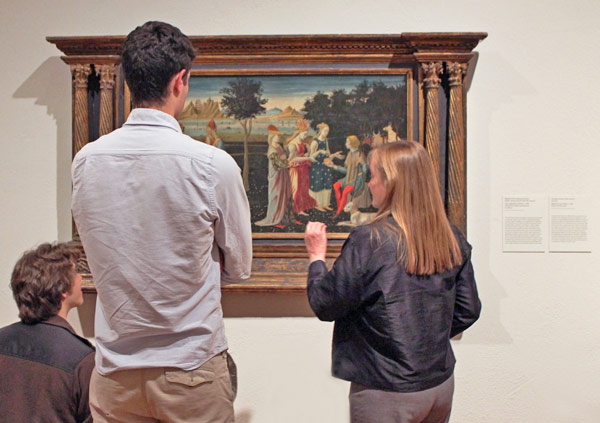On a recent spring day at the Arthur M. Sackler Museum, students from the Harvard College undergraduate course The Science of Living Systems 25: Trees, Forests, and Global Change toured the galleries with a scientist, conservator, and research curator from the Harvard Art Museums’ Straus Center for Conservation and Technical Studies. The students were visiting the museums to observe wood anatomy in artworks from our collections.
Narayan Khandekar, Senior Conservation Scientist, gathered the students around a long box filled with cards of verified wood specimens. He explained how dendrochronology, the science of dating events and environmental variations by studying growth rings in trees and aged wood, helps conservation scientists establish when, where, and how a painting was made—details that are important for understanding and authenticating works of art.
Khandekar, Conservator of Paintings Teri Hensick, and Research Curator Francesca Bewer led the class to a number of objects that were made with wood. The conservation team presented students with works spanning thousands of years— from Mummy Portrait of a Woman with Earrings, a painting on linden wood that was made in AD 130–40, to Alberto Burri’s 1956 painting, Legno e rosso 3, which features lacquered bark on its canvas.
Objects like these allowed the students to see the ways that wood plays an integral role in art—as substructure in panel paintings, as a stretcher and frame for those on canvas, as veneer on furniture, as a source of cellulose pulp in paper, as primary material for carved sculptures, and as a vehicle for the transfer of design in woodcut prints.
Students also learned how wood characteristics affect artworks—before objects are created and long after they are finished. For instance, different types and cuts of wood might be chosen for their cultural associations, and grain structure can determine the wood’s carving qualities and how the object might be affected by humidity. As the Straus group detailed how the construction and conservation of artworks has evolved over time to deal with issues such as buckling and cracking, students gained a fresh perspective on their biology and ecology studies.
A key facet of the Harvard Art Museums’ mission is to make its collections relevant to various fields of inquiry. To make this happen, the Division of Academic and Public Programs works to connect the museums to classrooms across campus. Read more about this exciting work here.




